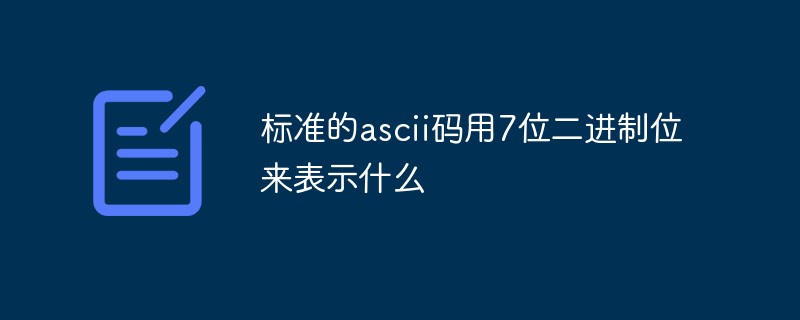
The standard ASCLL code uses 7 binary digits (the remaining 1 binary digit is 0) to represent 128 different codes. A 7-digit binary number (0000000~1111111), converted to decimal is (0~127), a total of 128 characters.

The operating environment of this tutorial: Windows 7 system, Dell G3 computer.
The standard ASCII code is represented by 7 binary bits and can represent 128 different codes.
Standard ASCII code is also called basic ASCII code. It uses 7 binary digits (the remaining 1 binary digit is 0) to represent all uppercase and lowercase letters, numbers 0 to 9, and punctuation marks. and special control characters used in American English; a total of 128 characters have been defined so far. Among them:
0~31 and 127 (33 in total) are control characters or special communication characters (the rest are displayable characters), such as control characters: LF (line feed), CR ( Enter), FF (page feed), DEL (delete), BS (backspace), BEL (ring), etc.; communication special characters: SOH (head of text), EOT (end of text), ACK (confirmation), etc.; ASCII values 8, 9, 10, and 13 are converted to backspace, tab, line feed, and carriage return characters respectively. They do not have a specific graphic display, but will have different effects on text display depending on the application.
32~126 (95 in total) are characters (32 is a space), of which 48~57 are ten Arabic numerals from 0 to 9.
65~90 are 26 uppercase English letters, 97~122 are 26 lowercase English letters, and the rest are some punctuation marks, arithmetic symbols, etc.
Also note that in standard ASCII, its highest bit (b7) is used as a parity bit. The so-called parity check refers to a method used to check whether errors occur during code transmission. It is generally divided into two types: odd check and even check. Odd parity rules: the number of 1's in a byte of the correct code must be an odd number. If it is not an odd number, add 1 to the highest bit b7; even parity rules: the number of 1's in a byte of the correct code must be an even number. , if it is not an even number, add 1 to the highest bit b7.
To read more related articles, please visit PHP Chinese website! !
The above is the detailed content of What does the standard ascii code use 7 binary bits to represent?. For more information, please follow other related articles on the PHP Chinese website!